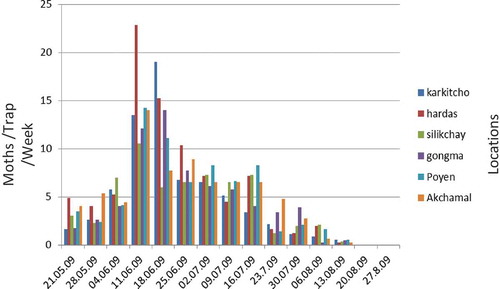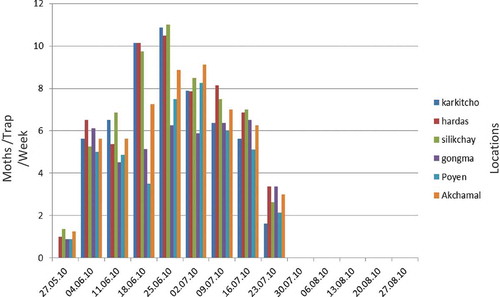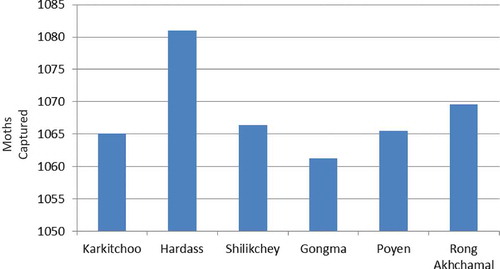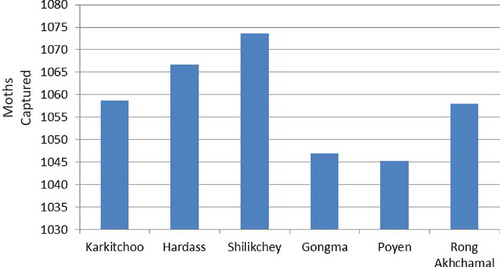Abstract
This study was conducted in six major apple growing areas of the Kargil region during 2009 and 2010; pheromone traps were evaluated for the monitoring and mass trapping of the codling moth. Monitoring the population dynamics of Cydia pomonella in 2009 revealed that the first catch was observed on 21 May, the highest on 11 June, and the lowest on 13 August at all of the locations. The dynamics were similar, but the population was lower in 2010. Climatic variables were more or less similar in both of the years. So, effective monitoring for the codling moth is essential and was highest in Hardas and lowest in Gongma during 2009 and highest in Shilikchey and lowest in Poyen in 2010.
KEYWORDS:
INTRODUCTION
The codling moth, Cydia pomonella L., is a menace in most of the major fruit producing areas of the world. It has been reported as a problem in Europe, USA, Canada, South Africa, Australia, New Zealand, Afghanistan, Pakistan, and Russia (Sheldeshova, Citation1976; Anonymous, Citation1969). In India its distribution is restricted to the Ladakh region of J&K State (Malik et al., Citation1972; Wadhi and Sethi, Citation1975). The pest is thought to have entered Ladakh from the North West Frontier province of Pakistan where it is reported as a serious pest on deciduous fruits (Janjua, Citation1938; Pruthi, Citation1938; Janjua and Samuel, Citation1941; Janjua et al., Citation1943). Distribution, damage, and biology of codling moth on apples in Ladakh was studied by Pawar et al. (Citation1981) and Zaki (Citation1999). In spite of very low temperatures, which fluctuate from 35 to −30°C, coupled with a low annual precipitation of less than 50 mm and a relative humidity of 15%–30%, the conditions appear to be very conducive for the development of this pest. The infestation of the codling moth on apple fruits was observed in all fruit growing areas of Kargil. Infestation of the codling moth in Ladakh showed that besides apple it also attacks pear, walnut, and apricot in a number of villages. All the cultivars of apple were found to be the preferred hosts for the pest. A recent survey conducted in different villages in Kargil and Leh revealed that the infestation of the pest on apple trees ranges from 42.2%–76.8% and on fallen fruit it ranges from 68.0% to 84.8%. Besides local apple cultivars, most of the introduced commercial cultivars, such as American Apirouge, Benoni, Red Gold, Royal Delicious, Red Delicious, Golden Delicious, Jelly Flower, Versifield, Cox’s Orange Pippen, American Pippen, and Ambri (Green), were found to be infested. Among the introduced cultivars, Red Delicious was the most affected (74.3%) while American Pippen, Cox’s Orange Pippen, and Versifield were least affected (20%–22%).
Cydia pomonella L. completes 1–2 generations in one season in the Ladakh region. Mature codling moth larvae over winter in silken cocoons under loose bark in cracks and crevices, in the soil, or in wooden materials present near apple plants or beneath stones beside infested trees. Pupation starts during the month of April and adult emergence takes place during early May and continues up to the last week of August depending upon temperatures. In the Ladakh region, the villages are scattered and isolated and more than 90% of the population in the Leh region are Buddhists and are against applying insecticides to control insect pests. Due to the small size of the land holdings in the fruit producing areas, there are no well established and regular orchards; instead the fruit trees stand closely planted along the boundaries of cereal, vegetable, or field crop fields. Moreover, the apple trees in the region have a spreading habit and are kept untrained, unpruned, and unmanaged. Under such circumstances insecticides are not effective or environmentally acceptable. Therefore, the use of pheromone technology for mass trapping should help to control this pest. This method will work best in this region because the apple trees are mostly planted in combination with apricot trees and not in combination with other trees harboring codling moth, such as pear and English walnut.
Mass trapping has been attempted for a variety of agricultural, orchard, and forest pests on a wide range of scales. The majority of mass trapping programs have been used for pest management rather than eradication programs. Mass trapping has been tested both as a stand-alone control method and in combination with insecticides (Huber et al., Citation1979; Jones, Citation1998). The key objective of mass trapping in pest management or eradication is to capture enough insects in the treated area before they reproduce or damage crops. In some programs mass trapping showed the potential for pest management with a significant reduction in target pest populations or in pest damage (Zhang et al., Citation2002). Several mass trapping programs that resulted in small to moderate reductions of pest numbers or damage were considered unlikely to provide adequate control, instead indicating methods or situations to avoid with this technology (Huber et al., Citation1979; Pasqualini et al., Citation1997). Mass trapping programs that provided no evidence of population or damage reduction were considered most likely to provide information on the conditions under which mass trapping should not be attempted, and this was also the case where the authors concluded that mass trapping was not suitable for the control of the pest (Yamanaka et al., Citation2000) or could not be recommended (Youm et al., Citation1997), although later improvements in technologies might alter this view. The present study was undertaken to evaluate the potential of pheromone traps in monitoring and mass trapping of the codling moth.
MATERIALS AND METHODS
Field experiments were performed in six major apple growing areas of the Kargil region (Karkitchoo, Hardass, Shilikchey, Gongma, Poyen, and Akhchamal) during 2009 and 2010 in which pheromone traps were evaluated for their potential in monitoring and mass trapping of codling moth. Traps and pheromone lures were purchased from M/S AG. Bio Systems Pvt. Ltd, Secunderabad, India and yellow-colored delta traps and grey Codlemone lures were used in the experiment. Each field trial included a plot (covering an area of about 0.5 acre) with eight apple trees, distributed randomly within the plot with apricot trees; each tree was hung with three pheromone traps and replicated eight times. Traps were placed in the upper, middle, and lower half of the tree canopy with a distance greater than 25 m between the plants so as to reduce the codling moth populations to a minimum in the field. During 2009, the traps were installed in all the locations during the 2nd week of May, while during 2010 pheromone traps were installed during the 3rd week of May at the pink bud stage and remained in the field until early September. The difference in date of installation of lures was due to the prevailing weather conditions during these years. However, the lures along with the septa and liners were replaced after 30 days. Thus, the subsequent date for lure change was the 2nd week of June and 2nd week of July during 2009 and the last week of June and July during 2010. Moths caught were counted and traps were cleared weekly. Trap catches were assessed monthly to obtain location estimates. Statistical analysis was performed using an analysis of variance (ANOVA) of the weekly catches in traps at all the locations. The field trials are described in .
TABLE 1 Locations and the Time of Installation of Pheromone Traps in Kargil, Ladakh, India
RESULTS AND DISCUSSION
The results of cumulative weekly trap catches of C. pomonella for different locations during 2009 and 2010 are depicted in and . The results revealed that the activity of the moths was noticed in the second week and in the last week of May during 2009 and 2010, respectively, at all the locations. The difference in the adult emergence was attributed to the fluctuation in temperature as cold weather prevailed even during May in 2010.The intensity of trap catches of moths was highest during 2009 as compared to 2010, at all the locations. Maximum trap catch was observed in Hardas, followed by Rong Akhchamal, Shilikchey, Poyen, Kirkatcho, and Gongma during 2009, while in 2010 the maximum moth trap catches were observed in Shilikchey followed by Hardas, Kirkatcho, Rong Akhchamal, Gongma, and Poyen. However, during both years a similar trend of moth populations was recorded showing a maximum population of moths captured per trap in the month of June in all the locations. However, a continuous fluctuation of moth capture/trap was observed during June and July, which could be attributed to the fluctuation in temperature. No moth capture was observed beyond the first week of August during 2010. However, during 2009, one to three moths/trap were recorded from the first week to the middle of August. The moth trap catches from August onwards during 2009 were due to late installation of pheromone baited traps and the fluctuations of adult populations were slightly less during this period.
During 2009, the adult emergence was observed during the 2nd week of May. The average number of moths caught per trap/week was observed as 6.5, 8.1, 6.6, 6.1, 6.5, and 6.9 at these locations, respectively. The results further revealed that during both years the trap catch was observed to increase from the first week of June and attained a peak during the last week of June. With the change of fresh lures on 25 June, the maximum number of moths was trapped at all the locations. The highest peak of moths/trap/week was observed during mid June and mid July at all the locations. During 2010, the adult emergence was observed during the last week of May and the average number of moths caught per trap per week was observed as 5.8, 6.6, 7.3, 4.7, 4.5, and 5.7 at these locations, respectively. Pitcairn et al. (Citation1992) reported that pheromone traps glued with lures are important tools for monitoring the adult population of the codling moth. The trap catch was observed to increase from the first week of June and attained a peak in the last week of June, and with the change of a fresh lure on 2 July, a maximum number of moths were trapped at all of the locations. Mass trapping of the codling moth during 2009 trapped more moths in Hardass than any other region of Kargil and the lowest moth catch was found in Rong Ackhmal ().
A significant difference was observed between the mass trapping of moths and locations (F5 = 450, P = 0.01) and in 2010 () more moths were trapped in Shilikchay followed by Hardass and the lowest was in Poyen and they significantly differed (F = 427, P = 0.01). The results further revealed that the monthly activity and mean number of moths caught per trap differ significantly at all the locations. The population density of codling moth was observed to be highest during the month of June followed by July in all the locations.
The intensity of moths trapped was highest during 2009 ( and ) and was the lowest during 2010 in comparison to the previous year (F = 188, P = 0.45). The differences in moth catches observed could be due to the fact that area wide codling moth management programs were operational from 2009, which had shown very significant results and were operated at every location of the Kargil Region from the selected sites. The trap catch was observed to increase again during July, but not to the extent as was observed during June and it attained a peak during the middle of July. The trap catch was observed to decrease significantly from mid July and reduced to nil from mid August during 2009 while during 2010 the trap catch reduced to nil from the last week of July. From the observations recorded during these 2 years, it was observed that the adult emergence of codling moth is temperature dependent. It started in the 2nd week of May during 2009 and the last week of May during 2010 and increased gradually and reached a peak during mid June and mid July. It was attributed to the weather factors (Pitcairn et al., Citation1990) and the implementation of an area wide pest management program. Farmers of Ladakh are not using any pest management strategy for management of this pest (Riedl et al., Citation1976) and a sharp temperature threshold has been observed for the onset and cessation of male flights. The time window for the male response to the pheromone is shorter on cold nights because of an earlier drop in temperature (Nabeta et al., Citation2005). Elevated temperatures may account for difficulties in achieving satisfactory control during the second seasonal flight period in the middle of the summer. Trematerra (Citation1993) considered mass trapping to be better than mating disruption on small hilly areas. Mass trapping has been investigated as a possible control option against the codling moth in North America and Europe where traps baited with a 1 mg lure at densities of 5–36 traps/hectare resulted in population suppression and, hence, a significant reduction in damage (Madeson and Carty, Citation1997; Emel’yanov and Bulyginskaya, Citation1999). Practical applications of the mass trapping technique require efficient and economic dispenser materials that release sufficient amounts of pheromone over an extended period. The purpose of this experiment was to monitor the peak population periods of codling moth so that mass trapping of the codling moth could be performed at the proper time. Ladakh is such a difficult region, where the scarcity of water and transportation problems are cause for concern and performing any integrated pest management program is too difficult because the people are not allowed to spray any insecticides. It is sin to kill pests in Ladakh because of religious constraints, so scientific diplomacy plays an important role in any sort of argument or IPM policy to monitor the population or to mass trap codling moths in these regions where we have succeeded through pheromone baited traps. Keeping this in view, from the results of the present investigation, it can be concluded that mass trapping can be an efficient and suitable pest management tool under the socio-economic conditions of the Ladakh region.
LITERATURE CITED
- Anonymous. 1969. Distribution maps of pests, series A (Agriculture). (Map, No. 9) Common Wealth Institute of Entomology, London, UK.
- Emel’yanov, V.A. and M.A. Bulyginskaya. 1999. Use of pheromones for control of codling moth, Laspeyresia pomonella L. (Lepidoptera, Tortricidae) by elimination and disorientation of males. Entomol. Rev. 79: 539–546.
- Huber, R.T., L. Moore, and M.P. Hoffman. 1979. Feasibility study of area-wide pheromone trapping of male pink bollworm moths in a cotton insect pest management programme. J. Econ. Entomol. 72: 222–227.
- Janjua, N.A. 1938. Codling moth in Afghanistan. Current Sci. 7:125.
- Janjua, N.A. and C.K. Samuel. 1941. Fruit pests of Baluchistan. ICAR Miscall. Bull. No. 42, 1–41.
- Janjua, N.A., A.M. Mustafa, and C.K. Samuel. 1943. On the biology and control of codling moth, Cydia pomonella in Baluchistan. Indian J. Agr. Sci. 13: 112–128.
- Jones, O.T. 1998. Practical applications of pheromones and other semiochemicals, p. 280–300. In: P. Howse, I. Stevens, and O.T. Jones ( eds.). Insect pheromones and their use in pest management. Chapman & Hall, London, U.K.
- Madeson, H.F. and B.E. Carty. 1997. Codling moth (Lepidoptera: Olethreutidae) suppression by male removal with sex pheromone traps in three British Columbia orchards. Can. Entomol. 111: 627–630.
- Malik, R.A., A.A. Punjabi, and A.A. Bhat. 1972. Survey study of insect and non-insect pests in Kashmir. Horticulture 3: 29–44.
- Nabeta, F.H., M. Nakai, and Y. Kunimi. 2005. Effects of temperature and photoperiod on the development and reproduction of Adoxophyes honmai (Lepidoptera: Tortricidae). Appl. Entmol. Zool. 40: 231–238.
- Pasqualini, E., S. Vergnani, D. Natale, and G. Accinelli. 1997. The use of sex pheromones against Zeuzera pyrina L. and Cossus cossus L. (Lepidoptera, Cossidae). Bull. OILB 20: 111–117.
- Pawar, A.D., N.C. Tuhan, S. Balsubramanian, and M. Parry. 1981. Distribution, damage and biology of codling moth, Cydia pomonella (L). Ind. J. Plant Protection 10: 111–114.
- Pitcairn, M.J., F.G. Zalom, and R.F. Rice. 1992. Degree-day forecasting of generation time of Cydia pomonella L. (Lepidoptera: Tortricidae) populations in California. Environ. Entomol. 21: 441–446.
- Pitcairn, M.J., F.G. Zalom, and W.J. Bentley. 1990. Weather factors influencing capture of Cydia pomonella (Lepidoptera: Tortricidae) in pheromone traps during overwintering night in California. Environ. Entomol. 19: 1253–1258.
- Pruthi, H.S. 1938. The distribution, status and biology of codling moth (Cydia pomonella L.) in Baluchistan with notes on some other insects infesting apple. Indian J. Agr. Sci. 9: 499–547.
- Riedl, H., B.A. Craft, and A.J. Howitt. 1976. Forecasting codling moth Carpocapsa pomonella phenology based on pheromone trap catches and physiological-time models. Can. Entomol. 108: 449–460.
- Sheldeshova, G. 1976. Ecological factors determining distribution of codling moth, Laspeyria pomonella L. (Lepidoptera: Torticidae) in northern and southern hemispheres. Entmol. Rev. 46: 349–361.
- Trematerra, P. 1993. On the possibility of mass-trapping Synanthedon myopaeformis Bkh. (Lep. Sesiidae). J. Appl. Entomol.115: 47–483.
- Wadhi, S.R. and G.R. Sethi. 1975. Eradication of codling moth—A suggestion. J. Nucl. Agr. Biol. 4: 18–19.
- Yamanaka, T., S. Tatsuki, and M. Shimada. 2000. Assessment of the synthetic sex pheromone traps for controlling the fall webworm, Hyphantria cunea (Drury) (Lepidoptera: Arctiidae), in an urban area of Japan. J. Environ. Entmol. Zool. 12: 69–75.
- Youm, O.B., D.R. Hall, L.J. McVeigh, and W.A. Overholt. 1997. The potential use of pheromones for the management of the millet stem borer, Coniesta ignefusalis (Hampson). Insect Sci. Applic. 17: 169–173.
- Zaki, F.A. 1999. Incidence and biology of codling moth, Cydia pomonella L. in Ladakh (Jammu and Kashmir). Appl. Biol. Res. 1: 75–78.
- Zhang, G.F., X.Z. Meng, Y. Han, and C.F. Sheng. 2002. Chinese tortrix, Cydia trasias (Lepidoptera: Olethreutidae): Suppression on street-planting trees by mass trapping with sex pheromone traps. Environ. Entomol. 31: 602–607.




